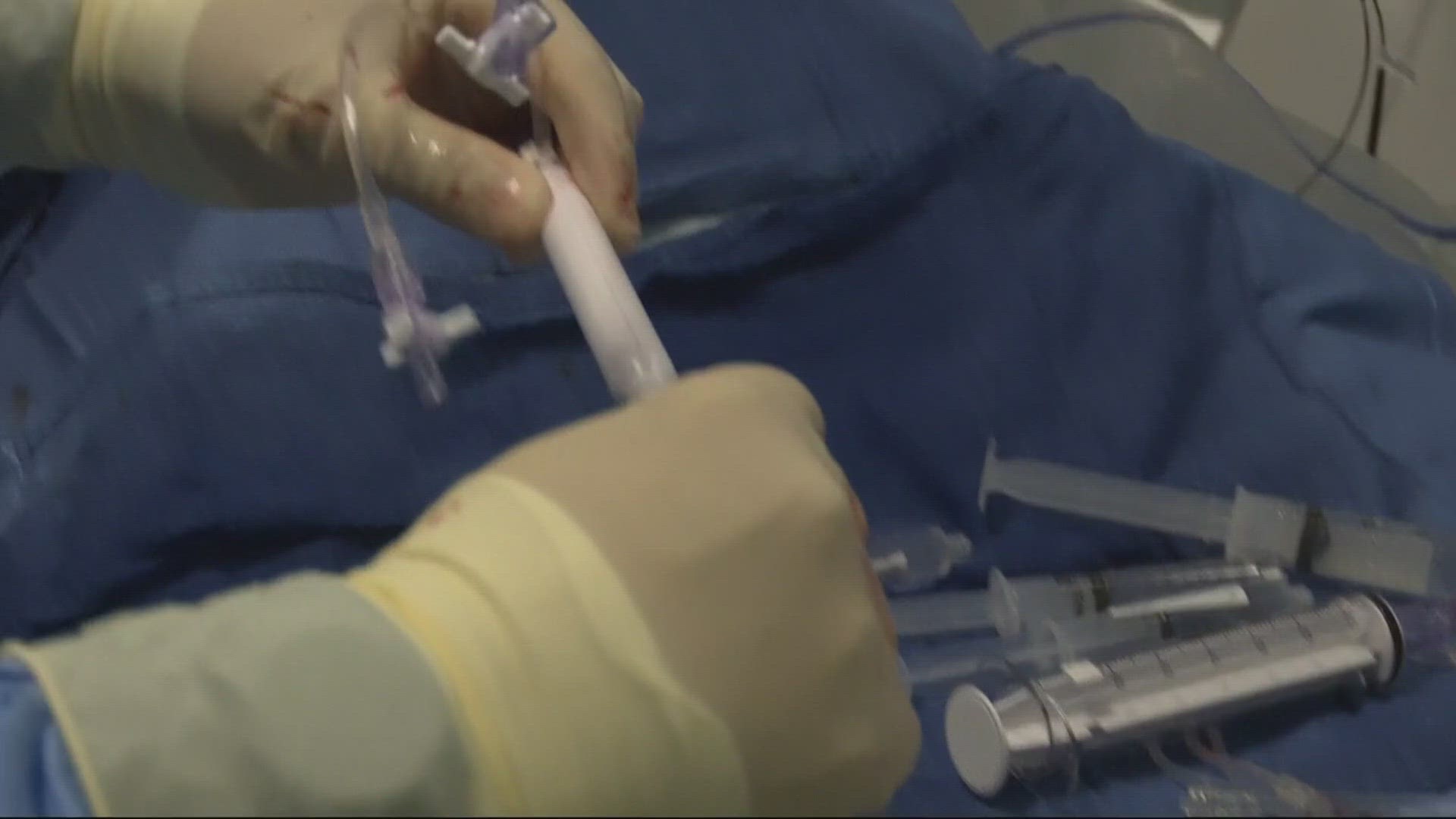JACKSONVILLE, Fla. — It's a surgical procedure that will save hundreds of lives and it was developed right here in Jacksonville. Until recently, patients with potentially lethal blood clots were typically given blood thinning medication with the hope that symptoms would improve.
First Coast News was given exclusive access of a procedure that is considered a medical breakthrough and getting national attention.
They can be life altering or even fatal, but blood clots are facing a new medical enemy. The team at HCA Florida Memorial Hospital pioneered the idea of having a team that uses a minimally invasive procedure to remove clots quickly and efficiently.
Calvin Nesset hasn't been able to go ballroom dancing with his wife like he used to.
"For several years, probably 10-12, I've had swelling in my right leg, calf and foot," said the 66-year-old Nesset. "The skin was starting to get thin and crepe."
The skin around his ankle was also starting to turn purple due to a blood clot that was preventing proper circulation. But Dr. Mohannad Bisharat and his team at HCA Memorial have a plan.
"This is a procedure that's not only going to extract the clot out of the patient's leg, which will restore function and viability of the limb, but it's also very important for prevention of pulmonary embolism," said Dr. Bisharat.
A pulmonary embolism is a blood clot in the lung, which can be deadly. The procedure that First Coast News had access to is a deep vein thrombosis, which will not only remove the clot from Nesset's leg, but also prevent that clot from migrating to a vital organ like the lung, which could kill him.
As Nesset is wheeled to surgery, the team that will be in the room puts on protective gear. No scalpels or anesthesia will be required.
"The whole entire procedure will be done through a little needle stick right here behind the knee," said Dr. Bisharat.
And the patient is awake the whole time in order to give feedback about discomfort during the procedure.
Dr. Bisharat inserts a catheter through the incision point to follow the vein up to the site of the blood clot. He uses an interventional wire and an interventional guiding catheter, by transferring torque on his end, the catheter moves in the actual vein.
This is all done with the hopes of lassoing the clot and pulling it out, hopefully in one piece.
The team monitors the progress with live-time ultrasound imaging, which shows the catheter wire and even Dr. Bisharat's wedding ring.
"This vein has been chronically occluded for some time now," said Dr. Bisharat, "it's acting hard to get, but we will get it."
An image from the ultrasound shows black coloring, which is actually blood, and where is stops in the vein due to the clot. Despite the discoloration in the patient's ankle, the clot is closer to his hip. The team will snake the catheter from behind the knee, through a vein and all the way to the middle of the abdomen.
"We quite often see a lot of chronic DVTs and when the blood clot organizes into layers of scar tissue in the vein it becomes tricky and difficult to cross," said Dr. Bisharat, "we are trying some new tricks to go around and manage to get through, we will get it."
A camera on the end of the catheter shows a 6 millimeter balloon expanding inside of the vein to give Dr. Bisharat extra space to work.
"Alright Mr. Nesset, we have everything we need now, we're going to start taking out the clot," said Dr. Bisharat to an awake patient.
"And now for the moment of truth," said Dr. Bisharat as the entire team stares at the live ultrasound imaging. Long black lines begin to appear on the ultrasound to indicate blood flow.
"Now the vein is wide open," said Dr. Bisharat, "those moments of sucess when we see the vein open is priceless."
They're life changing for the patient awake on the table during the procedure.
"The vein was 100% blocked," said Dr. Bisharat.
"Not bad for rebuilding a 66-year-old junker," replied Nesset.
As the catheter is removed, with is come the chunks of the blood clot. But will Calvin Nesset be able to return to the dance floor with his wife?
"100%, 100%," said Dr. Bisharat, "everything we've done here is geared towards improving the quality of life, but the other advantage is we've eliminated the chance of other blood clots to break off and go to the heart or lungs and cause more damage."
The entire procedure took 45 minutes, was performed through a tiny incision behind the knee and was closed with a simple stitch.
Dr. Bisharat said that the hospital has seen tremendous results with this procedure. This Spring, research from the team was featured in the Official Journal of the Society for Cardiovascular Angiography and Interventions. That full medical journal article mentioned earlier in this story can be read here.

